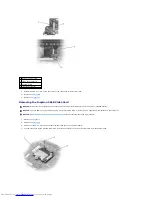
7.
Double-click the malfunctioning device type in the
Device Manager
list.
8.
Double-click the icon for the specific device in the expanded list.
The
Properties
window appears.
If an IRQ conflict exists, the
Device
status
area in the
Properties
window reports what other devices are sharing the device's IRQ.
9.
Resolve any IRQ conflicts.
You can also use Windows XP Hardware Troubleshooter. To use the troubleshooter, click the
Start
button and click
Help and Support
. Type
hardware
troubleshooter
in the
Search
field, and then click the arrow to start the search. Click
Hardware Troubleshooter
in the
Search Results
list. In the
Hardware
Troubleshooter
list, click
I need to resolve a hardware conflict on my computer
, and then click
Next
.
Windows 2000
1.
Click the
Start
button, point to
Settings
, and then click
Control Panel
.
2.
Double-click the
System
icon.
3.
Click the
Hardware
tab.
4.
Click
Device Manager
.
5.
Click
View
and click
Resources by connection
.
6.
Double-click
Interrupt request (IRQ)
to view the IRQ assignments.
Conflicts are indicated by a yellow exclamation point (!) beside the conflicting device or a red X if the device has been disabled.
7.
Double-click any conflicting device listed to bring up the
Properties
window so that you can determine what needs to be reconfigured or removed from
the Device Manager. Resolve these conflicts before checking specific devices.
8.
Double-click the malfunctioning device type in the
Device Manager
list.
9.
Double-click the icon for the specific device in the expanded list.
The
Properties
window appears.
If an IRQ conflict exists, the
Device status
area in the
Properties
window reports what other devices are sharing the device's IRQ.
10.
Resolve any IRQ conflicts.
You can also use Windows 2000 Hardware Troubleshooter. To use the troubleshooter, click the
Start
button and click
Help
. Click
Troubleshooting and
Maintenance
on the
Contents
tab, click
Windows 2000 troubleshooters
, and then click
Hardware
. In the
Hardware Troubleshooter
list, click
I need to
resolve a hardware conflict on my computer
, and then click
Next
.
Using Microsoft
®
Windows System Restore
The Window XP operating system provides a System Restore feature that allows you to return your computer to an earlier operating state if changes to the
computer's hardware or software (including new hardware or program installations), or other system settings, have left the computer in an undesirable
operating state. You can also undo the last
system restore
.
System Restore automatically creates system checkpoints. You can also manually create your own checkpoints by creating
restore points
. To limit the amount of
hard disk space used, older restore points will be automatically purged.
To resolve an operating system problem, you can use System Restore from Safe Mode or Normal Mode to return your computer to an earlier operating state.
System Restore does not cause you to lose personal files stored in the
My Documents
folder, data files, or e-mail messages after restoring the computer to an
earlier time. If you restore the computer to an operating state that existed before you installed a program, the program's data files are not lost, but you must
reinstall the actual program again.
System Restore is enabled on your new computer. However, if you reinstall Windows XP with less than 200 MB of free hard-disk space available, System
Restore is automatically disabled. Before you use System Restore, confirm that it is enabled:
1.
Click the
Start
button and click
Control
Panel
.
2.
Click
Performance and Maintenance
.
3.
Click
System
.
4.
Click the
System Restore
tab.
5.
Ensure that
Turn off System Restore
is not checked.
Creating a Restore Point
In Windows XP, you can either use the System Restore Wizard or manually create restore points.
Using the System Restore Wizard
NOTICE:
It is important to make regular backups of your data files. System Restore does not monitor changes to or recover your data files. If the
original data on the hard disk is accidentally erased or overwritten, or if it becomes inaccessible because of a hard disk malfunction, use your backup
files to recover the lost or damaged data.
Summary of Contents for Inspiron 2600
Page 3: ......
Page 22: ......
Page 67: ...Back to Contents Page ...
Page 75: ...Back to Contents Page ...






























